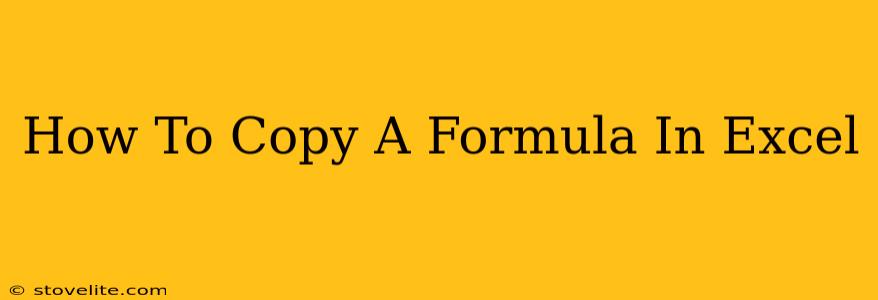Copying formulas in Excel is a fundamental skill for any user, enabling efficient data manipulation and analysis. Whether you're a beginner or an experienced user, mastering different copying techniques will significantly boost your productivity. This guide will walk you through various methods, ensuring you can seamlessly replicate your formulas across your spreadsheets.
Understanding Excel Formulas and Cell References
Before diving into copying techniques, it's crucial to understand how Excel handles cell references within formulas. A cell reference indicates the location of a specific cell (e.g., A1, B2, C3). There are two main types:
-
Relative References: These references change relative to the new cell's location when a formula is copied. For instance, if you copy the formula
=A1+B1from row 1 to row 2, it automatically adjusts to=A2+B2. This is the default behavior. -
Absolute References: These references remain constant regardless of where the formula is copied. To create an absolute reference, use the dollar sign (AA1
,AA$1` will always refer to cell A1, no matter where the formula is copied.
Methods for Copying Excel Formulas
Here are several ways to copy formulas in Excel, catering to different situations and user preferences:
1. Using the Fill Handle
This is the quickest and most common method:
- Select the cell containing the formula you want to copy.
- Hover your mouse over the small square (the fill handle) at the bottom right corner of the selected cell. The cursor will change to a plus sign (+).
- Click and drag the fill handle down or across to the cells where you want to copy the formula. Excel automatically adjusts relative references.
This method is ideal for copying formulas to adjacent cells in a row or column.
2. Using the Copy-Paste Method
This method offers more control, especially when dealing with absolute and relative references:
- Select the cell containing the formula.
- Press Ctrl+C (or Cmd+C on a Mac) to copy the formula.
- Select the cell(s) where you want to paste the formula.
- Press Ctrl+V (or Cmd+V on a Mac) to paste the formula.
This is useful for copying formulas to non-adjacent cells or when you need to choose specific paste options (like pasting only values).
3. Using the Fill Command (for more complex scenarios)
- Select the cell with the formula.
- Go to the Home tab.
- In the Editing group, click the small arrow below the Paste button to open the Paste Special menu.
- Choose Fill and select Down, Across, Series, etc., depending on your needs.
This offers granular control over how the formula is copied, especially beneficial when copying to non-contiguous ranges.
4. Copying Formulas to Entire Columns or Rows
For copying a formula down an entire column or across an entire row:
- Select the cell with your formula.
- Double-click the fill handle. This will automatically copy the formula down to the last cell in the column containing data in the adjacent column.
This is an incredibly time-saving technique for large datasets.
Troubleshooting Common Issues
-
Incorrect Results: Double-check your formula and cell references, paying close attention to absolute and relative references. Ensure your data is correctly formatted.
-
#REF! Error: This error usually appears when a formula refers to a cell that no longer exists (e.g., after deleting rows or columns). Adjust your cell references accordingly.
-
#VALUE! Error: This often occurs when a formula is trying to perform an operation on an incompatible data type (e.g., adding a number to text). Ensure your data types are consistent.
Mastering these techniques for copying formulas in Excel will dramatically improve your efficiency and allow you to leverage the power of spreadsheets for more advanced tasks. Remember to practice and experiment to gain confidence and proficiency.

